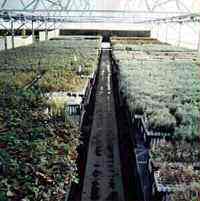|
VEGETATIVE PROPAGATION BY
DIVISION
Some plants have fleshy roots or stems that can be cut
into sections, so that a new plant grows from each section.
This is called division. These stems and roots have special
names.
The crown of some plants is the part near the surface of
the ground from which new shoots come. When the clump gets
large, it can be cut apart. Examples include: day lily,
phlox, peony, and rhubarb.
Rhizomes are underground stems. Examples include:
lily-of-the-valley and bearded iris.
Tubers, like Irish potatoes or kumara, are swollen,
underground stems that store food.

A well known and often eaten
tuber!
Roots like dahlia store food too.
Each of these is treated differently. Finding out their
unique requirements can be fun!
VEGETATIVE PROPAGATION BY
LAYERING
Layering is a method of making roots develop on a stem
while it is still attached to the parent plant. After roots
form, it can be cut free and planted. Layering usually works
best in spring or late summer. There are many different
methods of layering.
In simple layering, a low branch is bent to the
ground and buried, except for the tip. Wounding the branch
helps roots to form. Do this by cutting part-way through the
part that will be buried. Examples of plants you can do this
with include: cotoneaster, forsythia, quince, and some
roses.
Air layering is used on rubber plants and other
indoor woody plants. Wound the stem, or remove a ring of
bark, about 30cm from a branch tip. Wrap the place with damp
sphagnum moss. Tape plastic around this to keep it in place.
Keep the moss moist. Roots should form in a few weeks to
several months. When they form, cut off the stem below the
roots and plant.

What kind of propagation do you think they
would be using in this shade house?
Back to Top
|